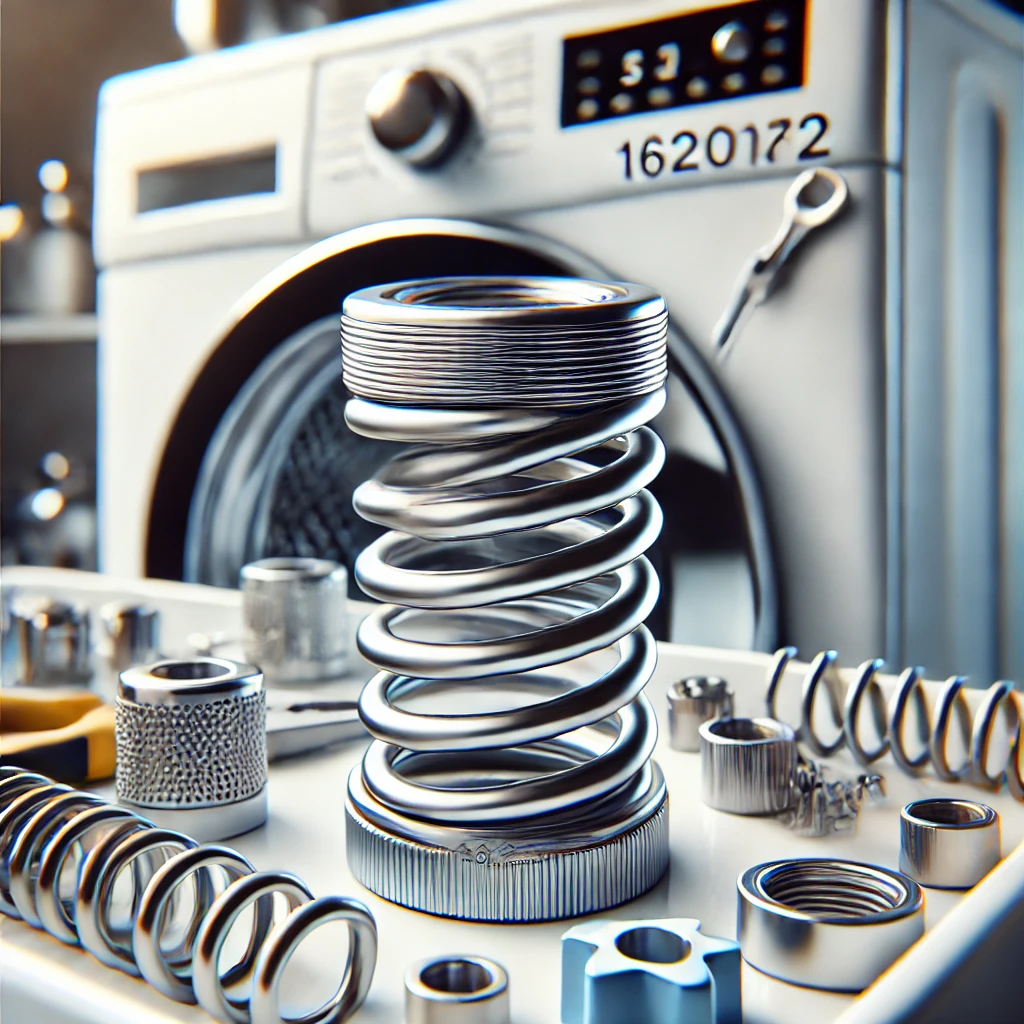Introduction
When it comes to maintaining your washing machine, you may not give much thought to the small but vital components that keep it running smoothly. One such part is the 1620172 washer lock spring. While it might seem insignificant, this spring plays a crucial role in ensuring your appliance operates efficiently. In this guide, we’ll explore the purpose of the 1620172 washer lock spring, common issues that can arise, how to replace it, and essential maintenance tips to keep your washing machine in top shape.
What is the Purpose of the 1620172 Washer Lock Spring?
The 1620172 washer lock spring is an essential part of your washing machine’s locking mechanism. Its primary function is to keep the drum secure and in place during the washing cycle. Without it, the drum can move excessively, causing vibrations, imbalanced loads, and even damage to other components of your appliance.
This spring helps maintain balance, which is crucial for ensuring that the washing machine operates efficiently. A stable washer will not only clean clothes better but also produce less noise and reduce the wear and tear on its parts. By keeping the drum steady, the 1620172 washer lock spring ensures smoother operation throughout the cycle.
Signs of a Faulty 1620172 Washer Lock Spring
It’s important to recognize the early signs of a malfunctioning 1620172 washer lock spring. Identifying these issues early can save you from costly repairs or more significant damage to your washing machine.
- Excessive Vibrations or Noise:
If you notice that your washing machine vibrates or makes unusual noises during the cycle, the washer lock spring could be to blame. A worn-out spring may cause the drum to move uncontrollably, leading to disruptive sounds. - Washer Door Issues:
If the washer door doesn’t stay securely locked, this could be a sign that the 1620172 washer lock spring has lost its tension. The door might pop open during washing cycles, leading to leaks or interruptions. - Visible Damage:
Inspect the spring regularly for signs of corrosion, rust, or physical damage. If you notice any visible wear and tear, it may be time to replace the part before it fails completely. - Imbalance During Washing:
When the washer’s load is unbalanced or unevenly distributed, the lock spring helps maintain stability. If your machine is unbalanced despite proper loading, the spring might not be functioning properly.
Common Issues with the 1620172 Washer Lock Spring
Over time, the 1620172 washer lock spring can experience several issues, particularly due to continuous exposure to water and wear. Here are some of the most common problems:
- Loss of Tension:
The most frequent issue is the loss of tension in the spring. As the spring wears down, it may not be able to keep the washer drum secure during the spin cycle. This can result in malfunctioning and uneven spinning, causing damage to the appliance. - Corrosion and Rust:
The 1620172 washer lock spring is often exposed to moisture, which can lead to rust and corrosion over time. A rusted spring may break prematurely or fail to function properly, resulting in leaks or other issues with the washing machine. - Misalignment:
Another problem that can occur is misalignment. If the spring becomes loose or shifts out of place, it will no longer engage properly with the other components, which could severely affect the appliance’s performance.
How to Replace a Faulty 1620172 Washer Lock Spring
Replacing the 1620172 washer lock spring is not as difficult as it sounds, and doing so can save you from costly repairs. Here’s a step-by-step guide to replacing the spring:
- Unplug the Appliance for Safety:
Before you begin, ensure that the washing machine is unplugged from the power source. This is important to avoid electrical hazards. - Access the Washer’s Interior:
Depending on the model of your washing machine, you may need to remove the outer casing. This typically involves unscrewing several bolts or screws around the back or sides. - Locate the Faulty Lock Spring:
Once you’ve removed the casing, locate the 1620172 washer lock spring inside the machine. The spring is usually mounted near the drum’s locking mechanism. - Remove the Old Spring:
Carefully detach the old lock spring. You may need pliers or a wrench to loosen it if it is firmly in place. Be gentle to avoid damaging surrounding components. - Install the New Washer Lock Spring:
Take the new 1620172 washer lock spring and secure it in place. Make sure it is positioned correctly and tightly so it can engage properly with the rest of the washer’s locking mechanism. - Reassemble the Washing Machine:
Once the new spring is in place, reassemble the machine by securing all the parts and screws you removed earlier. - Test the Washer:
Plug the washing machine back in and run a test cycle. If the machine operates smoothly without unusual vibrations or sounds, you’ve successfully replaced the 1620172 washer lock spring.
Troubleshooting Minor Issues with the 1620172 Washer Lock Spring
Sometimes, minor issues can arise with the 1620172 washer lock spring that don’t require a full replacement. Here’s what you can do to troubleshoot:
- Check for Obstructions:
If your washer isn’t functioning properly, check the area around the spring for dirt, debris, or other obstructions that could be affecting its performance. - Adjust Tension:
If the spring is loose, you may be able to tighten it slightly. Follow your user manual for guidance on adjusting the spring’s tension. - Re-align the Spring:
If the spring seems misaligned, carefully reposition it. Be sure it’s correctly seated and in contact with the relevant components.
Tips for Maintaining the 1620172 Washer Lock Spring
Proper maintenance is key to extending the life of your 1620172 washer lock spring. Here are some simple tips to keep it in good condition:
- Regular Inspections:
Check the washer lock spring periodically for signs of wear, rust, or corrosion. Early detection can help prevent larger issues. - Clean the Washer’s Interior:
Keep the inside of your washing machine clean by wiping down the drum and surrounding components. Dust and debris can cause unnecessary strain on parts like the lock spring. - Avoid Overloading:
Overloading the washing machine places undue stress on the internal parts, including the washer lock spring. Stick to recommended load limits to ensure longevity. - Properly Distribute Laundry:
When loading your washer, evenly distribute the clothes around the drum to maintain balance. This reduces strain on the lock spring and other components.
Benefits of Using High-Quality Washer Lock Springs
Investing in a high-quality 1620172 washer lock spring can provide several benefits for your washing machine:
- Improved Durability:
A high-quality spring will last longer, reducing the frequency of replacements and improving overall appliance performance. - Better Functionality:
With a reliable lock spring, your washer will operate more efficiently, reducing the chances of vibrations, noise, and imbalances. - Cost Savings:
A durable spring means fewer repairs, translating to savings in the long term. High-quality parts can prevent more expensive issues down the line.
Environmental Impact of Discarding Washer Lock Springs
Replacing the 1620172 washer lock spring is necessary at times, but it’s essential to consider the environmental impact. Many springs can be recycled, reducing waste and conserving resources. Instead of discarding the old spring, look into local recycling programs or check with your appliance repair provider to see if they offer recycling options.
Conclusion
The 1620172 washer lock spring is a small but vital component in your washing machine. Understanding its role, recognizing potential issues, and performing regular maintenance can help extend the life of your appliance. By following the steps outlined in this guide, you can ensure that your washing machine operates smoothly and efficiently. Whether you’re replacing the spring yourself or having it serviced, staying proactive will save you time and money in the long run.
Remember, a well-maintained washer lock spring is key to keeping your machine running smoothly and preventing larger issues down the road. By investing in quality replacement parts and regular care, you’ll enjoy a more reliable appliance for years to come.


